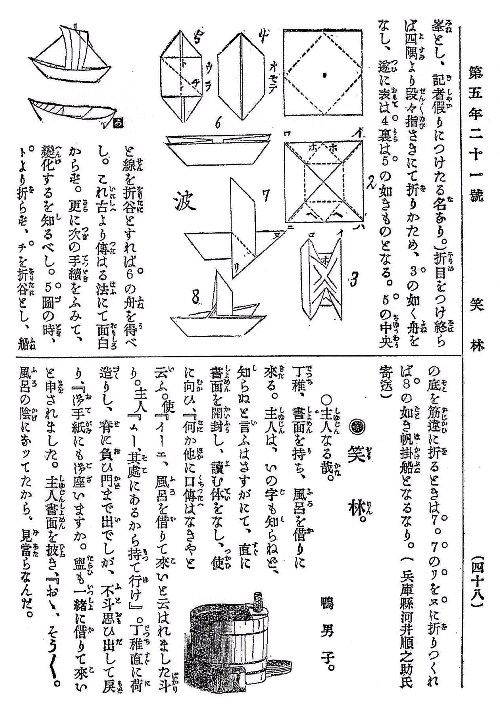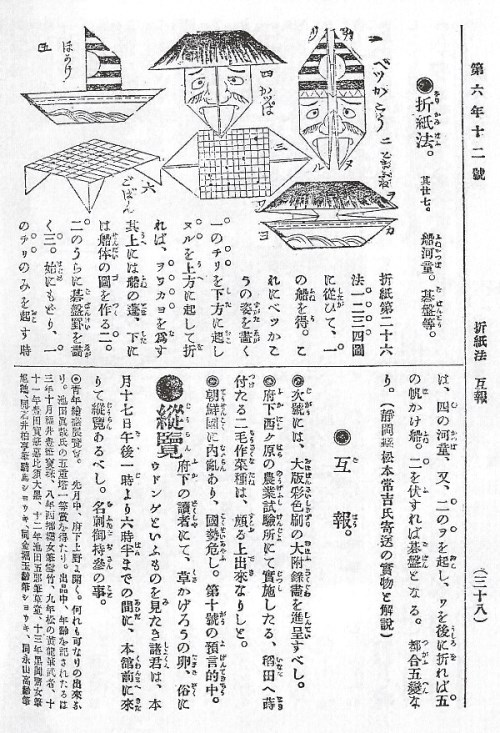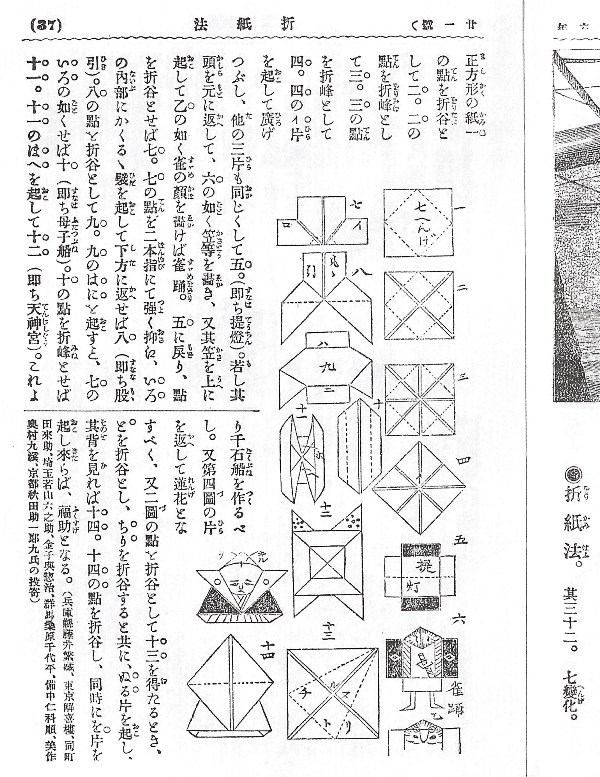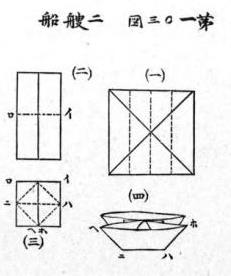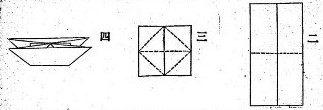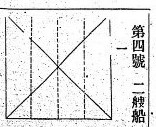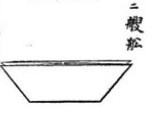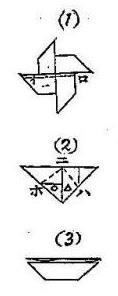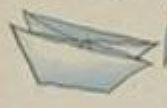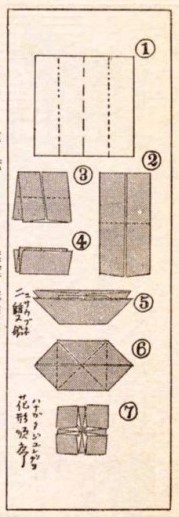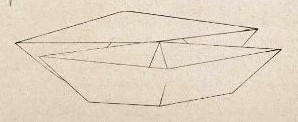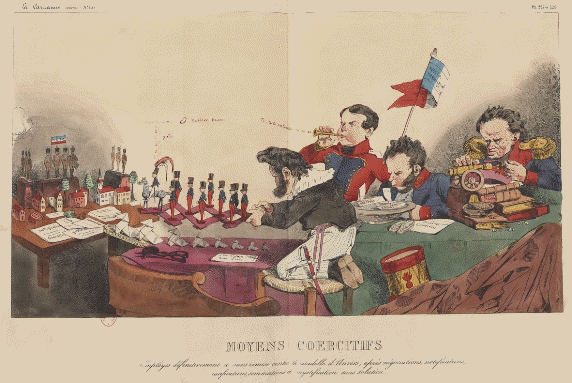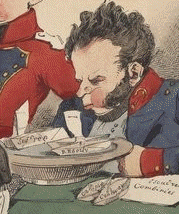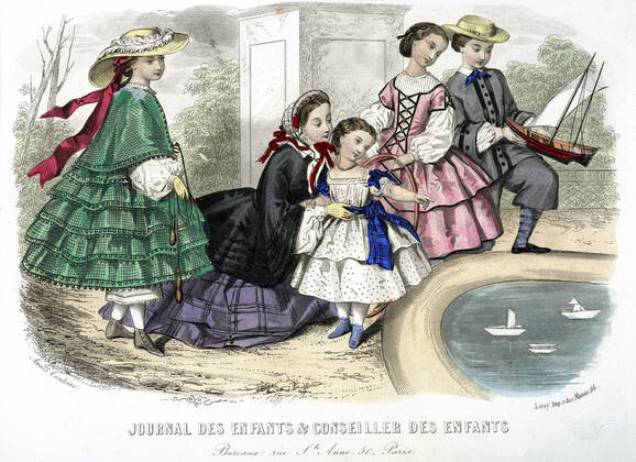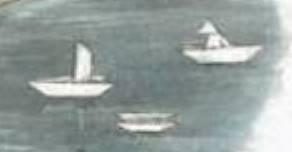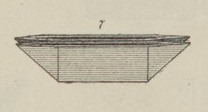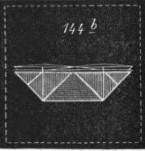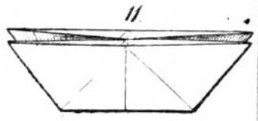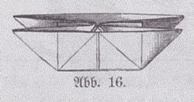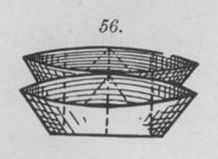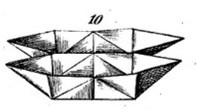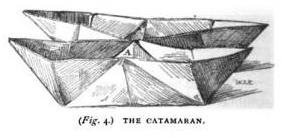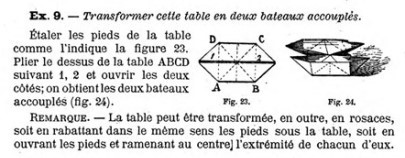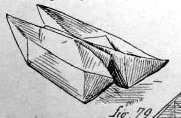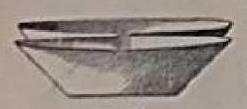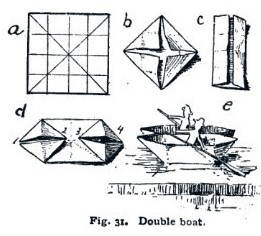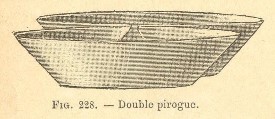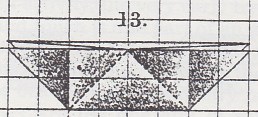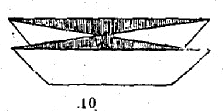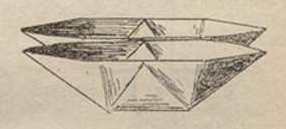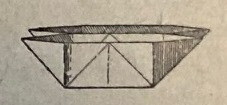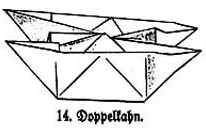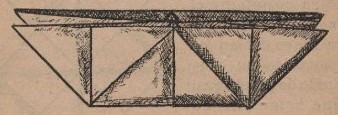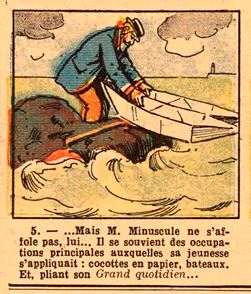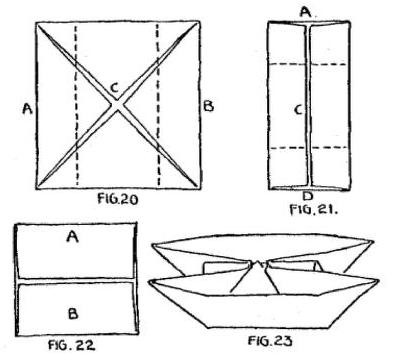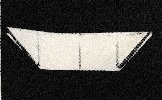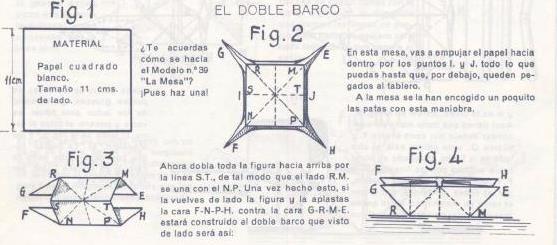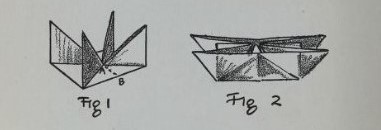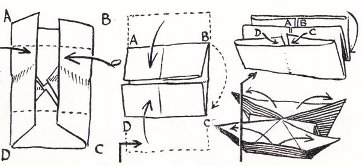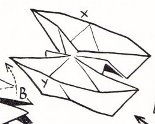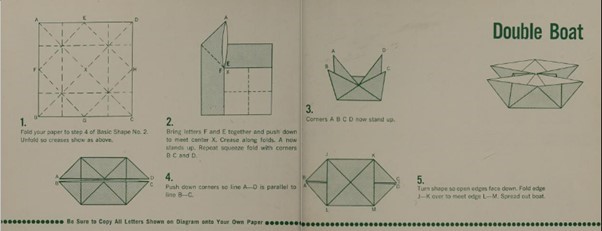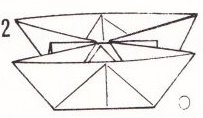| The Public Paperfolding History Project
Last updated 12/10/2025 x |
|||||||
| The Double Boat (Nisobune) / The Double Hulled Boat | |||||||
| This
page is being used to collect information about the
history of the paperfolding design known as the Double
Boat or, in Japan, as the Nisobune. Please contact me if
you know any of this information is incorrect or if you
have any other information that should be added. Thank
you. There are two versions of the Double Boat, one developed from a single layer square and the other from a blintzed square. The Double Boat folded from a single layer square can be developed into the Double Fishbox / Portfolio, the Open Box and ultimately the Gondola. The Double Boat folded from a blintzed square can be developed into designs such as the Double Boat with Sail, the Double Boat with Two Sails, the Junk Box and ultimately the Chinese Junk. These two versions of the design are visually indistinguishable. In order to distinguish between them I call the design folded from a single layer square the Double Boat and that folded from a blintzed square the Double Hulled Boat. It is not, of course, always possible to know which of the two versions is being pictured if there is no context to allow a distinction to be made, and it is possible that I have made errors when trying to decide which is which. ********** In China (and in publications by Chinese authors) 1914 Diagrams for this design appear in 'Zhe zhi tu shuo' (Illustrated Paperfolding), compiled by Gui Shaolie, which was published by the Commercial Press in Shanghai in Ming guo 3 (1914).
********** In Japan (and in publications by Japanese authors) In Japan a flattened Double Boat form appears as an intermediate form in the folding sequence of the Tenjin Shrine, which is the base for the Takarabune. It does not appear as a design in its own right until after the founding of the first Japanese kindergarten in 1876 and thus can be considered to be an imported design. 1878 A picture of the Double Boat appears in 'Yochien Ombutsu No Zu', a publication of kindergarten material issued by the Tokyo Women's Normal School in 1878.
********** 1893 The Double Boat appears as part of a 'Transforming Ship' sequence in 1893 in volume 5 issue 21 of 'Shokokumin' children's magazine.
********** 1894 A flattened Double Boat appears (twice) in a Japanese folding pictures form in issue 12 of the Japanese children's magazine 'Shokokumin' in 1894. The instructions say that you should draw on each part of the boat as shown in the pictures. The flattened boat at the upper right is titled 'Bekkako' (a type of toy with a funny face) and the one at lower right 'Tomabune' (a boat with a roof made of woven straw).
********** Issue 21 of the same magazine in the same year contains the same design under the name 'Futatsubune'.
********** 1903 Diagrams for the Double Boat appear in 'Jinjo Kouto Shogaku Shuko Seisakuzu' (Handicrafts for ordinary higher elementary schools) by Hideyoshi Okayama, which was published by Rokushiro Uehara in Tokyo in 1903.
********** 1904 The design also appears in 'Shukouka Kyoju Shishin: Maiji Haitou' by Hyojiro Nakagaki, which was published by Kenseikai in Tokyo in 1904. Note that this design is developed from the Double Bookfold Basic Form.
********** 1905 A picture of the design appears in 'Shukouka Kyohon : Liron Jishuu Souga Setsumei' by Kikujiro Kiuchi, Rokushiro Uehara and Hideyoshi Okayama, which was published by Shigebei Takase in Chiba in 1905.
********** A drawing of the design also appears in 'Shukoka Kyoju Saian' by Gentaro Tanahashi and Hideyoshi Okayama, which was published by Hobunkan in Tokyo in 1905.
********** 1907 Diagrams appear in 'Shukou Tebikigusa : Kokumin Kyoiku Origami Yuihimo' by Ishin Nishigaki, which was published by Meguro Shoten in Nagaoka in 1907.
********** 1908 Diagrams that show how to convert the Windmill into the Double Boat appear in 'Origami zusetsu' (Illustrated Origami) by Sano Shozo, which was published in Tokyo in 1908.
********** 1910 As 'Doppelkahn' in 'Allerlei Papierarbeiten' by Hildergard Gierke and Alice Kuczynski, which was published by Drud und Verlag B G Teubner in Leipzig and Berlin in 1910.
********** 1912 A drawing of a flattened version of the Double Boat appears in a monozukushi-e print, by an unknown artist, but said to be from the Meiji era. I have temporarily assigned it the date of 1912, the last year of that era, pending the discovery of more accurate information.
********** 1927 A drawing of the Double Boat appears in an illustration by Takei Takeo in a 1927 issue of the children's magazine 'Kodomo No Kuni' (The Land of Children).
********** 1931 The Double Boat also appears in 'Origami (Part 1)' by Isao Honda, which was first published in Japan in 1931.
********** 1935 'Origami Moyo, Book One', by Kawarazaki Kodo, which was published by Unsodo in Japan in 1935, contained a print showing a double boat.
********** 1944 In 'Origami Shuko' by Isao Honda, which was published in 1944.
********** 1951 As 'Nisobune' in 'Origami to Kirinuki' by Saburo Ueda, which was published by Kokkado in Tokyo, most probably in 1951.
********** 1965 As 'Double Boat', in 'The World of Origami' by Isao Honda, which was published in the USA by Japan Publications Trading Company in 1965.
********** 1967 As 'Double Boat' in 'Origami Folding Fun: Kangaroo Book' by Isao Honda, which was published by Japan Publications Inc in Tokyo in 1967.
********** In Europe and the Americas 1832 The earliest appearance of the Double Boat that I know of is in issue 110 of the French satirical magazine 'La Caricature', which was published on 13th December 1832. The cartoon also includes a Boat with Sail and a parade of Cocottes, apparently advancing to attack a village. My thanks to Jaume Coll Guerrero for this information.
********** 1858 The design also appears in this illustration by Anais Toudouze in le 'Journal des Enfants et Conseiller des Enfants', said to date from 1858.
********** 1859 Both the Double Boat and the Double Hulled Boat appears in lists of designs in the 'Manuel Pratique de Jardins D'Enfants de Friedrich Froebel', which was compiled by J F Jacobs and published in Brussells and Paris in 1859. In this case, although there are no illustrations in the book, the context makes it clear which design is which. ********** 1863 Both 'De schuitjes' (boats), ie the Double Boat, and 'Twee schuitjes' (two boats), ie.the Double Hulled Boat appear, in 'De Kleine Papierwerkers 1: Wat men van een stukje papier al maken kan: Het vouwen' (The Small Paperwork 1: What one can make from a piece of paper: Folding) by Elise Van Calcar, which was published by K H Schadd in Amsterdam in 1863.
********** 1869 A design called 'Einen Doppelkahn', which is not illustrated, but which from the context is most probably the Double Boat, appears in a list of designs in 'Der Kindergarten' by Hermann Goldammer, which was published by Habel in Berlin in 1869. ********** 'Paradise of Childhood' by Edward Wiebe, which was published by Milton, Bradley and Company in Springfield, Massachusetts in 1869, and is effectively a translation of Goldammer's 'Der Kindergarten', similarly includes 'a duble canoe' in its list of Forms of Life. ********** 1873 There is reference to 'La double pirogue' (the double canoe) in a list of designs in 'Exercices et Travaux pour les Enfants Selon la Méthode et les Procédés de Pestalozzi et de Froebel' by Fanny and Charles Delon, which was published by Librairie Hachette in Paris in 1873. Unfortunately there is no illustration to confirm the identification of the design. ********** A double boat also appears, as 'Doppelboot', in 'Die Praxis Des Kindergartens' by August Koehler, which was published by Herman Bohlau in Weimar in 1873.
********** A double boat also appears, as 'Kahn' in 'Bilder aus dem Kindergarten fur Mutter und Erzhieherrinen' by Ernst Barth, which was published in Leipzig in 1873.
********** 1874 The Double Boat appears in the revised version of 'Der Kindergarten' by Hermann Goldammer which was published by Carl Babel in Berlin in 1874.
********** 1875 As 'Twee schuitjes' in 'Froebels Methode' by Elise Van Calcar, which was published in 1875. The design appears twice in this work, the second time folded from a blintzed square as part of the sequence leading to the Chinese Junk.
********** In the second edition of 'Praktischer Wegweiser fur den Unterricht in der Elementarklasse' (Practical Guide for Teaching in the Elementary Class) by Anton Fruhwirth, Alois Fellner and Georg Ernst which was first published by A Pichler's Witwe & Sohn in Vienna in 1875.
********** 1876 The Double Boat appears in 'Des Kindes Erste Beschaftigungsbuch' by E Barth and W Niederley, which was first published in Bielefeld and Leipzig, and the foreword of which is dated October 1876.
********** 1877 The design is mentioned, but not illustrated in 'Kindergarten Practice' by Mary Gurney, which is a substantially abridged version, in two parts, of 'Die Praxis Des Kindergartens' by Auguste Koehler. The second part, 'Froebel's Plane Surfaces', contains sections dealing with paper folding, cutting and weaving. The date of the first edition is not known. The second edition was published in 1877 in London by A N Myers and Co. ********** The design also appears as 'Doppelkahn' in part 2 'Die Praxis' of 'Theoretisches und praktisches Handbuch der Fröbelschen Erziehungslehre' by Bertha von Marentholtz-Bülow, which was published by George H Wigand in Kassel in 1887.
*********** 1880 The Double Boat appears in 'The Kindergarten Principle' by Mary J Lyschinska, which was published in London in 1880 by Wm Isbister Ltd.
********** 1882 The Double Boat appears in Part two of 'The Kindergarten Guide' by Maria Kraus Boelte and John Kraus, which was probably first published in 1882 by E. Steiger and Company in New York.
********** 1883 As 'Einen Doppelkahn' in 'Der Kindergarten' by A S Fischer, which was published by Alfred Holder in Wien in 1883.
********** 1888 As 'Catamaran' in 'Wide Awake: Volume Z', which was published by D Lothrop Company in Boston in 1888.
********** 1890 Diagrams for 'Deux bateaux accouples' appear in 'Les travaux manuels a l'ecole primaire a l'usage des ecoles de garcons' by Dauzat and Deramond, which was published by Alcide, Picard et Kaan in Paris in 1890.
********** 1890 The design appears in versions folded from both a singly blintzed and a doubly blintzed square as 'Bateau double' in 'Le travail manuel a l'ecole et dans la famille' by MM, Bertrand, Toussaint and Gombert, which was published by Loucene, Oudin et ces Editeurs in Paris in 1890.
********** 1891 The Double Boat appears in 'Pleasant Work for Busy Fingers' by Maggie Browne, published by Cassell and Company in London in 1891, which is an English version of 'Des Kindes Erste Beschaftigungsbuch' enhanced by the addition of a few extra designs. ********** 1892 In 'Le Travail Manuel a L'ecole Primaire' by Jully & Rocheron, which was published by Librairie Classique Eugene Belin in Paris in 1892.
********** In 'The Prang Primary Course in Art Education: Part 1: The First Primary Year' by Mary Dana Hicks and Josephine C Locke, which was published by the Prang Educational Company in Boston in 1892.
********** 1893 As the 'Double Pirogue' in 'L'Annee Preparatoire de Travail Manuel' by M P Martin, which was published by Armand Collin & Cie in Paris in 1893.
********** In 'Practical Suggestions for Kindergartners, Primary Teachers and Mothers' by Jeannette R Gregory, which was published by C B Woodward and Co in St Louis in 1893.
********** In 'Paper and Scissors in the Schoolroom' by Emily Weaver, which was published by Milton Bradley Company in Springfield, Massachusetts in 1893
********** 1894 In 'Jeux et Occupations Pour les Petits: Guide des Mères et des Institutrices' by Henriette Suzanne Brés was published by Librairie Classique Fernand Nathan in Paris in 1894.
********** 1895 As 'A Double Boat' in 'Course of Paperfolding' by Eleonore Heerwart, which was published by Charles and Dible in London and Glasgow in 1895. The second version is folded from a different groundform.
********** In a sample book of Froebelian paperfolds and papercuts etc made by by Laura B Thompson in 1895.
********** In an article 'A Paper Bird, a Double Boat and a Workshop Hat' by Burnett Fallow in the 'The Boy's Own Paper' of 2nd November 1895.
********** 1897 As 'Bateau double' in 'Pliage et Decoupage du Papier' by C Savineau, which was published by Librairie Hatchette et Cie in Paris in 1897. The work also explains how to lay two Double Boats together to create a parallelogram.
********** In Lois Bates' 'Kindergarten Guide', which was first published by Longmans, Green and Co in London in 1897.
********** 1899 In 'Le Livre des Amusettes' by Toto, which was published in Paris by Charles Mendel in 1899.
********** In an article in 'El Monitor' 321 of 31st December 1899.
********** 1900 In 'Introduccion a la Ensenaza Practica del Sistema de Kindergarten' by Ernesto Steiger, which was published by E Steiger and Co in New York in 1900.
********** 1903 In 'La Ensenanza del Trabajo Manuel' by Pedro de Alcántara García and Teodosio Leal y Quiroga, which was published in Madrid in 1903.
********** As 'Le double bateau' in an article by Alber in the French children's magazine Mon Journal of 6th June 1903.
********** 1904 In 'Guia Practica del Trabajo Manual Educativo' by Ezequiel Solana, which was published by Editorial Magisterio Español in Madrid in 1904.
********** As 'Doppelschiffen' in 'Handbüchlein der Papierfaltekunst' (Handbook of Paperfolding Art) by J Sperl, which was first published by by H Hartleben's Verlag in Wien and Leipzig in 1904.
********** 1907 A design called 'barcas del bou' and 'lanchas del bou' is mentioned, but not illustrated, in an article titled 'El trabajo manual escolar' by Vicente Casto Legua in the January 1907 issue of the Spanish magazine 'La Escuela Moderna' which was published in Madrid by Los Sucesores de Hernando. This design is almost certainly the Double Boat. ********** 1908 As 'Le double bateau' in 'Les Petits Secrets Amusants' by Alber-Graves, which was published by Librairie Hachette in Paris in 1908. This design begins from a blintzed square and is therefore the Double Hulled Boat.
********** 1910 As 'Doppelkahn' in Part 2 'Das Flechten' of 'Die Frobelschen Beschaftigungen' by Marie Muller-Wunderlich, which was published by Friedrich Brandstetter in Leipzig in 1910.
*********** The method of folding the Double Boat, called the Catamaran, is described, but not illustrated, in 'Studies in Invalid Occupation' by Susan E Tracy, which was published by Whitcomb and Barrows in Boston in 1910. *********** As 'Double Boat' in 'Educational Handwork' by T B Kidner, which was published by The Educational Book Company Limited in Toronto in 1910.
********** 1914 As 'El barco doble' in 'El Trabajo Manual en la Escuela' by Félix Martí Alpera, which was published by Libreria de los Sucesores de Hernando in Madrid in 1914.
********** This cartoon strip featuring the Double Boat appeared in Supplément Illustré du Petit Comtois on 28th June 1914.
********** 1918 As 'Doble barca / Langosta' (Lobster) in 'Ciencia Recreativa' by Jose Estralella, which was published by Gustavo Gili in Barcelona in 1918. The text says, roughly, 'Some call this figure a lobster because standing on JK-LM it jumps if it is hit on B o D' (ie if standing normally it will jump if both points at one end are struck simultaneously). No illustration provided.
********** 1920 The Double Hulled Boat appears in 'Paper Magic' by Will Blyth, which was first published by C Arthur Pearson in London in 1920.
********** 1927 As 'Doppelkahn' in 'Lustiges Papierfaltbüchlein' by Johanna Huber, which was published by Otto Maier in Ravensburg, Germany, probably in 1927.
********** 1928 The Double Hulled Boat appears in 'Fun with Paperfolding' by William D Murray and Francis J Rigney, which was published by the Fleming H Revell Company, New York in 1928.
********** c1929 As 'Doble barca' in booklet 2 of 'Trabajos Manuales Salvatella - Plegado de figuras de papel', which was published by Editorial Miguel A Salvatera in Barcelona, pobably in or around 1929.
********** 1939 As 'Doble bota' in 'Trabajo Manual Educativo' by Araminta V Aramburu, which was published by F Crespillo in Buenos Aires in 1939.
********** As 'Barco Doble' in 'Plegado' by Rufino Yapur, which was published by Editores Independencia in Buenos Aires in 1939.
********** As 'El Barco Doble' in 'El Mundo de Papel' by Dr Nemesio Montero, which was published by G Miranda in Edicions Infancia in Valladolid in 1939.
********** As 'The Catamaran' in 'Fun with Paper' by Joseph Leeming, which was published by Spencer Press Inc in Chicago in 1939.
********** 1940 As 'Bote Doble' in 'El Plegado y Cartonaje en la Escuela Primaria' by Antonio M Luchia and Corina Luciani de Luchia, which was published by Editorial Kapelusz in Buenos Aires in 1940.
********** 1952 As 'Barca Doble' made from a blintzed square in 'Una Hoja de Papel' by Lorenzo Herrero, which was published by Miguel A Salvatella in Barcelona in 1952.
********** 1956 Both versions appear in 'Paper Magic' by Robert Harbin, which was published by Oldbourne in London in 1956, the Double Boat as a separate design and the Double Hulled Boat as part of the 'Multiform' sequence. Both are called the Catamaran. The Double Boat
*** The Double Hulled Boat
********** 1960 The Double Boat also appears in 'Origami: The Oriental Art of Paper Folding' by Harry C Helfman, which was published by Platt and Munk Co Inc in New York in 1960.
********** 1961 As 'Doppelkahn' in 'Wir Falten' by Joachim Schönherr and Gerta Schumann, which was published by Rudolf Arnold Verlag in Leipzig in 1961. ********** 1964 The Double Hulled Boat appears, titled the 'Catamaran', in 'Secrets of Origami', by Robert Harbin, which was published by Oldbourne Book Company in London in 1964, as part of the Multiform sequence.
********** |
|||||||


